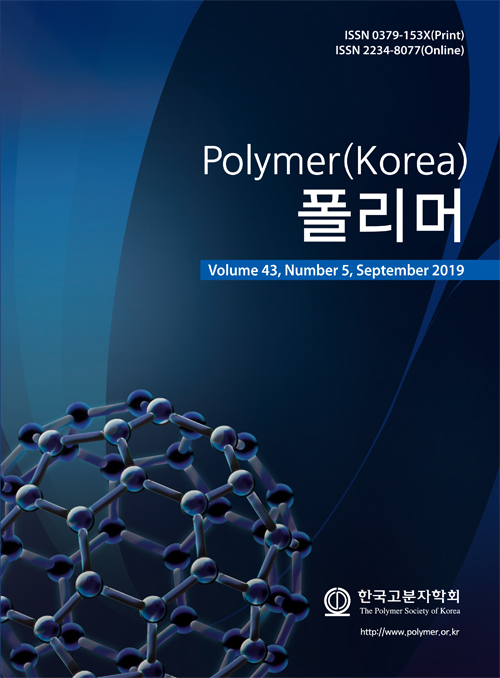- Effect of Dispersant on Encapsulated Phthalocyanine/Polymer Nanoparticles via Mini-emulsion Polymerization
Hyo Won Kwak*,**, Jae-Hun Han***, Yeonkyung Hong***, Jungju Eom***, Jin-Kyun Lee***, and Hyoung-Joon Jin***,†

*Department of Forest Sciences, Seoul National University, 1 Gwanak-ro, Gwanak-gu, Seoul 08826, Korea
**Research Institute of Agriculture and Life Sciences, Seoul National University, 1 Gwanak-ro, Gwanak-gu, Seoul 08826, Korea
***Department of Polymer Science and Engineering, Inha University, Incheon 22212, Korea- 미니 유화 중합을 통한 프탈로시아닌 안료의 캡슐화에 분산제가 미치는 영향
*서울대학교 산림과학부, **서울대학교 농업생명과학연구원, ***인하대학교 고분자공학과
In this study, phthalocyanine green pigment encapsulated polymer particles were prepared by mini-emulsion polymerization method and the particle size and color change according to the ratio of pigment and dispersant were examined. Triton X-100 dispersant was used to disperse the phthalocyanine green pigment, and the characteristics of the dispersibility and stability were evaluated while adjusting the concentration of the dispersant to 0, 0.2, 0.4, and 0.8% (w/v) in the pigment dispersion. As the concentration of Triton X-100 increased, the dispersibility of the pigment was clearly improved. Without Triton X-100 dispersant, the spherical particles with diameters of 3-4 µm and 200-300 nm were polymerized at the same time due to the mini-emulsion instability. However, when dispersant was added, pigments were successfully dispersed and the mini-emulsion was well stabilized. As a result, phthalocyanine green encapsulated polymer particles which had the spherical shape with diameter of 200-300 nm were uniformly polymerized. The effect of the dispersant concentration was directly related to the mini emulsion stability and the pigment encapsulation efficiency. Field emission scanning electron microscopy (FE-SEM), transmission electron microscopy (TEM) and dynamic light scattering (DLS) were used to characterize the morphology and particle size distribution of the polymerized particles, and Fourier-transform infrared spectroscopy (FTIR), thermo-gravimetric analysis (TGA) and ultraviolet-visible spectroscopy (UV-Vis) were used to evaluate the characteristics of encapsulation efficiency. As a result, it was confirmed that the highest encapsulation efficiency was obtained when 0.4% (w/v) of Triton X-100 was used.
본 연구에서는 미니 유화 중합법을 통하여 프탈로시아닌 그린 안료를 캡슐화한 고분자 입자를 제조하였으며, 안료 및 분산제의 비율에 따른 입자 크기 및 색상 변화를 알아보았다. 프탈로시아닌 그린 안료를 안정하게 분산시키기위해 Triton X-100 분산제를 사용하였고, 안료분산액에서 분산제의 농도를 0, 0.2, 0.4, 0.8%(w/v)으로 조절하면서 입자의 특성을 평가하였다. Triton X-100의 농도와 안료의 분산성은 비례관계를 보였지만, 일정 수준이상의 분산제의 증가는 분산 안정성의 큰 변화가 없었다. 분산제가 첨가되지 않고 캡슐화를 진행할 경우 3-4 μm 이상 및 200-300 nm 크기의 구형 입자가 동시에 중합되었다. 한편, 분산제가 첨가됨으로써 안료의 분산성이 증가하고 이와 관련한 미니 유화 상태가 안정적으로 유지되어 200-300 nm 직경의 구형 입자가 균일하게 중합되었다. 분산제 농도의 영향은 입자 중합에 직결되었을 뿐만 아니라 안료 캡슐화의 효율에 큰 영향을 미쳤다. 중합한 입자의 모폴로지와 입경분포도에 대한 특성 평가를 위해 주사전자현미경(field emission scanning electron microscopy), 투과전자현미경(transmission electron microscopy) 및 동적 광산란법(dynamic light scattering) 분석을 실시하였고, 안료 캡슐화 효율을 푸리에 변환 적외선 분광법(Fourier-transform infrared spectroscopy), 열중량분석법(thermo-gravimetric analysis), 자외선 및 가시광선 분광법(ultraviolet-visible spectroscopy)을 이용하여 분석한 결과, 0.4%(w/v)의 Triton X-100을 첨가하였을 경우 가장 높은 캡슐화 효율을 보이는 것으로 확인하였다.
Keywords: phthalocyanine, mini-emulsion polymerization, encapsulation, copolymer
- Polymer(Korea) 폴리머
- Frequency : Bimonthly(odd)
ISSN 0379-153X(Print)
ISSN 2234-8077(Online)
Abbr. Polym. Korea - 2023 Impact Factor : 0.4
- Indexed in SCIE
 This Article
This Article
-
2019; 43(5): 716-721
Published online Sep 25, 2019
- 10.7317/pk.2019.43.5.716
- Received on Apr 25, 2019
- Revised on Jun 18, 2019
- Accepted on Jun 18, 2019
 Correspondence to
Correspondence to
- Hyoung-Joon Jin
-
Department of Polymer Science and Engineering, Inha University, Incheon 22212, Korea
- E-mail: hjjin@inha.ac.kr









 Copyright(c) The Polymer Society of Korea. All right reserved.
Copyright(c) The Polymer Society of Korea. All right reserved.